Daehangno: Tasty food with a touch of art
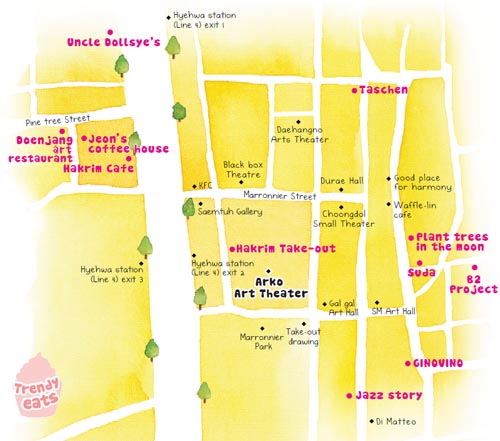
Illustration by Park Jae-won
It’s an area in Seoul that historically has a unique, off-beat - if a bit faded - appeal. A neighborhood in western Seoul known as Arko Town in Daehangno, embraces 16 universities and stands for what youth is all about.
“What makes Daehangno unique is its unbounded sense of liberty, which other areas cannot emulate,” said Jeong Ju-ri, a 21-year-old woman with braids like Pippi Longstocking.
And Jeong is not biased; the area has more than 130 theaters and performing art centers in every nook and cranny, oozing ardent spirit.
But there is something else that distinguishes this area.
Daehangno cafes, restaurants and bars are making themselves distinctive by adding an artistic personality to their business.
“The future of eateries here lies in specialization with a unique concept,” said Song Yeon-sang of the Neighbor Daehangno real estate agency.
In the 1960s and 70s, the area was the heart of the resistance movement against the military dictatorship, where writers gathered to share their views. In the 70s, when the government even cracked down on men’s hair length and women’s skirts, Daehangno served as a way out for the young, who sang for the zeitgeist of the times with an acoustic guitar. During the 80s, it was the stage for a plethora of Korean rock bands that emulated Led Zeppelin.
“Until the mid-90s, Daehangno experienced its heyday,” said Song. “It is true that the buzz has quieted down.”
But what might have saved the area is the fact that it has also long been known as a mecca of performing arts.
“People come [to Daehangno] because they know that it is a home for clowns and theater folk,” said Kim Cheol-min, a red-haired, maverick comedian who gives performances in front of the Arko Arts Theater, the bedrock of the neighborhood that opened in 1981 and provides the area’s namesake.
And now, restaurants are relying on Daehangno’s unique atmosphere to help revitalize the area, some holding onto a long tradition of offering food amid street theater, with others coming into the scene with fresh, new ideas.
A few dabang, or Korean coffeehouses, remain as relics of the past. One is Hakrim coffee shop, a stubborn establishment that still operates the same way it did in 1956 when it opened.
“Time cannot be deliberately forged,” said Lee Chung-yeol, owner of Hakrim coffee.
The sky is the limit in the art world and with this concept in mind, creativity was the basis for the birth of some out-of-the-ordinary restaurants.
There are cafes called Planting Trees in the Moon and B2 Project. Both are gallery cafes where customers can view an art exhibition while sipping an espresso or splurging on a Belgian waffle.
“The purpose is for people to look at art and have a discussion about it together like an art club,” said Kim Jung-hee, owner of Planting Trees in the Moon.
B2 Project, opened in October 2009, is a multiple-use space of design and art, accommodating a gallery in the basement, a cafe on the first floor and an art studio on the second. Every three to five months, the gallery offers a new art exhibit featuring a budding artist. The purpose of the gallery, director Byun Jae-hee says, is “to promote and support new amateur artists who have talent by introducing their work to the customers visiting the cafe.”
GinoVino is a wine bar extraordinaire. The owner, Kim Jin-ho, designs and manufactures furniture. At this newly launched bar, which opened about a month ago, Kim’s works are displayed for anyone to purchase if they wish. Visitors can also find a table that Kim made as a first assignment for renowned architect Seung Hyo-sang.
For art buffs, there is art-book cafe called Taschen Classic 1812. The cafe’s close relationship with German art publisher Taschen means it can hang a tile photo of Marilyn Monroe on the wall and display Taschen books all over the cafe. Lee Sang-man, the president of Taschen, started the cafe to promote modern art and music. Taschen Classic 1812 also offers live classical performances by Korean professionals.
If the four cafes above captivate the eyes, Suda cafe uses the sense of touch. It is a felt-art cafe. The entire interior is designed with felt, even down to the tables.
“My goal is to expose felt art to Korea and make it the next art industry boom,” said Kim Yu-jeong, owner of the cafe.
There are also other places that allow people to use their sense of hearing. In a crowded field of standard Italian fare, Di Matteo mixes things up for food from the Mediterranean country. Pizza is cooked in a brick oven, and the restaurant performs a play every Wednesday and Friday on their theater stage.
Jazz Story offers three live jazz performances every evening, and while you might think the place looks like a junk house - complete with a bicycle hanging from the ceiling. But owner Im Ae-gyun likes this, taking unwanted and recycled items and decorating the place with them. And once the moon rises and the jazz band starts playing, customers start tapping their feet and swaying to the beat. A regular customer, Lee J.H., who works for the Seoul Theater Association, said, “The facilities here may not be the best in the nation, but you can feel an irreplaceable artistic soul.”
Eateries in Daehangno may not be palatable to those of high-brow tastes. Rather, its culture is more experimental and kitsch. But for those who dare to enjoy the experimental spirit of art, the cultural sphere offers a plethora of spectacles that incorporate art not under the sway of pure commercialism.
“Even ‘fresh-comers’ soon become fascinated by the charms once they visit,” said the comedian Kim.
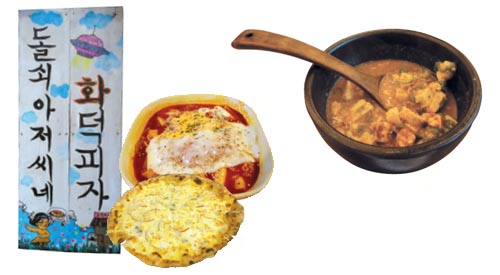
Uncle Dollsye’s / Doenjang Art
Uncle Dollsye’s
This kitschy artistic-looking restaurant decorated with cartoonish pictures is a hip place among those in their teens and 20s. Uncle Dollsye’s is also famous for its cheese tteokbokki and pizza.
Cheese tteokbokki costs 6,500 won ($6). Pizza ranges from 11,000 to 16,500 won.
Dollsye’s set menu includes cheese tteokbokki, an omelette and desert, and costs 13,900 won.
Hours are 11 a.m. to 9 p.m. from Monday to Saturday.
Myungryun 4-ga, Jongno-gu, 23
(02) 765-7399
Doenjang Art
This restaurant specializes in kang doenjang (bean paste) and makes bibim doenjang (mixed doenjang) that is less salty but still has a tangy spicy taste.
Prices range from 8,000 won to 45,000 won. Hours are 10 a.m. to 10:30 p.m. from Monday to Sunday. Myungryun 4-ga, Jongno-gu, 103-8, (02) 745-4516
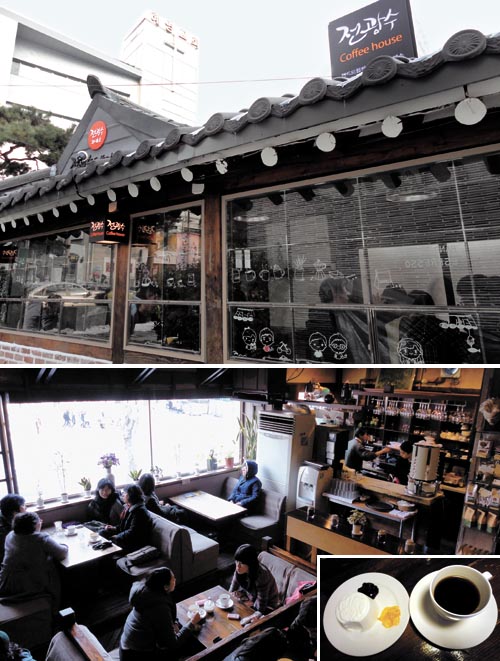
Jeon Gwang-su Coffee House / Hakrim, since 1956
Jeon Gwang-su Coffee House
Run by students of the Jeon Gwang-su coffee academy. Jeon learned how to make coffee from a Salvadorian.
Coffee prices range from 3,500 won to 6,500 won. Hours are 9 a.m. to 11 p.m. from Monday to Sunday.
Myungryun 4-ga, Jongno-gu
(02) 3672-0233
www.jeonscoffee.co.kr
Hakrim, since 1956
This landmark cafe opened in front of Seoul National University College of Liberal Arts in 1956 and houses more than a thousand LP records. Coffee price ranges from 4,500 won to 7,000 won. Homemade cheesecake is 5,000 won.
Hours are Monday to Sunday 10 a.m. to 12 p.m.
Myungryun-dong, Jongro-gu, 94-2
(02)742-2877
http://www.hakrim.pe.kr
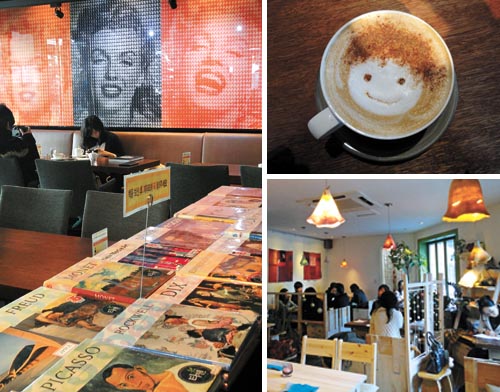
Taschen Classic 1812 (left) / Planting Trees in the Moon / Suda
Taschen Classic 1812
Taschen Classic 1812 is a huge two-story art-book cafe where customers can enjoy live music performances while munching on food and sipping wine.
The Taschen chicken sandwich is 8,000 won. Dinner prices range from 15,000 won to 35,000 won. Coffee prices range from 5,000 won to 6,000 won.
Hours are 11:30 a.m. to 2 a.m. from Tuesday to Sunday.
Dongsung-dong, Jongno-gu, 1-81
(02) 3673-4115 http://www.taschencafe.com/book_taschen
Planting Trees in the Moon
This unique cafe offers art exhibitions and even works that people can purchase, all while enjoying coffee and dessert.
Coffee prices ranges from 4,000 won to 6,500 won.
Hours are 1 p.m. to 10 p.m. from Monday to Friday and 12 p.m. to 10 p.m. on the weekends
Dongsung-dong, Jongro-gu, 128-5
02) 763-1204, http://blog.daum.net/dalna
Suda
Enjoy coffee, tea or wine in this felt-art studio and cafe. Felt-art lessons are 50,000 won per session for anyone interested in learning the craft. The instructor, who learned about felt art in England, is also Suda cafe’s owner.
Drink prices range from 4,500 won to 5,500 won.
Hours are 12 p.m. to 11:30 p.m. from Monday to Saturday and 12 p.m. to 11 p.m. on Sunday
Dongsung-dong, Jongno-gu, 128-12
(02) 762-7565, www.cafesuda.com
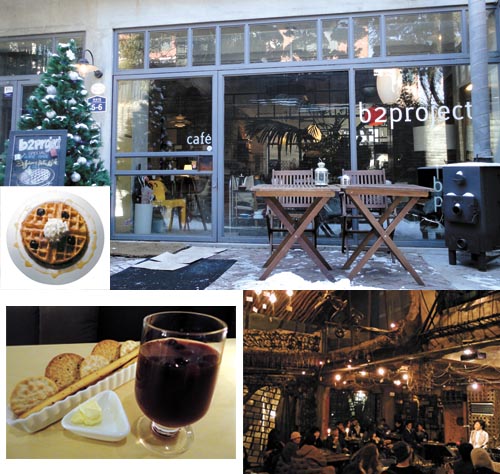
B2 Project / GinoVino (left) / Jazz Story (right)
B2 Project
B2 Project has a basement art gallery, first-floor cafe and a space for artists to rent out on the second floor. The cafe has tasty Belgian waffles at prices ranging from 9,000 won to 17,000 won for a set.
Drink prices range from 4,500 won to 7,000 won.
Hours are 12 p.m. to 11 p.m. from. Tuesday to Sunday
Dongsung-dong, Jongno-gu, 130 1-1
(02) 747-5435
www.b2project.co.kr
GinoVino
A wine bar with furniture for sale, GinoVino’s unusual juxtaposition actually creates quite a good combination with a touch of chic and a cozy atmosphere. The owner, Kim Jin-ho, designs and manufactures furniture. Wine prices range from 30,000 won to 300,000 won a bottle. A glass of house wine costs 7,000 won. Hours for the furniture display are 10 a.m. to 6 p.m., and the bar is open from 6 p.m. to 12 a.m.
Dongsung-dong, Jongno-gu, 1-152
(02) 765-2660
Jazz Story
Jazz Story’s house band, No Name Band, performs live every night.
Cocktail prices ranges from 9,000 won to 11,000 won. Beer is available from 7,000 won to 15,000 won. The performance is 5,000 won. Hours are 5 p.m. to 2 a.m. from Monday to Sunday
Daehakro 12-gil 86, Jongno-gu
(02) 747-6537, www.jazzstory.co.kr
By Yoo Sun-young, Lee Jung-hee [estyle@joongang.co.kr]










with the Korea JoongAng Daily
To write comments, please log in to one of the accounts.
Standards Board Policy (0/250자)